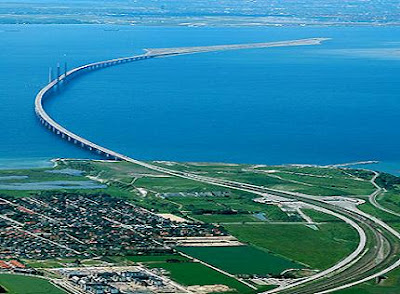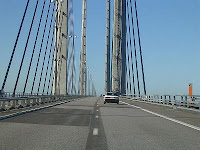The Oresund Bridge is a combined two track rail and four lane road bridge tunnel across the Oresund strait. It is the longest combined road and rail bridge in Europe and connects the two metropolitan areas of the Oresund Region the Danish capital of Copenhagen and the Swedish city of Malmo. The international European route E20 runs across the bridge and through the tunnel via the two lane motorway, as does the Oresund Railway Line. The construction of the Great Belt Fixed Link and the Oresund has connected mainland Europe to Sweden and the rest of Scandinavia. The bridge was designed by the Danish architectural practice Dissing and Weitling.
 The reason for incurring the additional cost and complexity of building a tunnel instead of another section of bridge is to avoid obstructing aircraft from nearby Copenhagen Airport and to provide a clear path for shipping. The bridge crosses the border between Denmark and Sweden, but thanks to the Schengen Agreement there are no passport controls. There are frequent customs checks at the toll booths for those entering Sweden but not for those entering Denmark.
The reason for incurring the additional cost and complexity of building a tunnel instead of another section of bridge is to avoid obstructing aircraft from nearby Copenhagen Airport and to provide a clear path for shipping. The bridge crosses the border between Denmark and Sweden, but thanks to the Schengen Agreement there are no passport controls. There are frequent customs checks at the toll booths for those entering Sweden but not for those entering Denmark.In Sweden and Denmark the bridge is most often referred to as Oresundsbron and Oresundsbroen, respectively. The bridge company itself insists on Oresundsbron, a compromise between the two languages. This symbolises a common cultural identity for the region, the people becoming "Oresund citizens" once the bridge is established. Since the crossing actually comprises a bridge, an island, and a tunnel, it is sometimes called, more accurately, the "Oresund Link" or “Oresund Connection". The Sound Bridge is occasionally heard, using the traditional English name for the strait.
Construction of the crossing began in 1995. It was finished on 14 August 1999. Crown Prince Frederik of Denmark and Crown Princess Victoria of Sweden met midway on the bridge to celebrate the completion. The official inauguration took place on 1 July 2000, with Queen Margrethe II, and King Carl XVI Gustaf as guests of honour. Initially, the crossing was not used as much as expected, probably because of the high cost. Since 2005, there has been a rapid increase in traffic. This may have been caused by Danes buying homes in Sweden to take advantage of lower house prices in Malmo and commuting to work in Denmark
At 7,845 m or 25,738 ft, the bridge covers half the distance between Sweden and the Danish island of Amager, the border between the two countries being 5.3 km or 3.3 mi from the Swedish end. The structure has a mass of 82,000 tonnes and supports two railway tracks beneath four road lanes in a horizontal girder extending along the entire length of the bridge. On both approaches to the 3 cable-stayed sections, the girder is supported every 140 m or 459 ft by concrete piers. The 2 pairs of free-standing cable supporting towers are 204 m or 669 ft high allowing shipping 57 m or 187 ft of head room under the main span. Even so, most vessels prefer to pass through the unobstructed Drogden Strait above the Drogden Tunnel. The 490 m or 1 ,608 ft cable-stayed main span is the longest of the type in the world. The architect is George Rothne, and the structural design is by Arup.

 The connection between the artificial island of Peberholm and the artificial peninsula at Kastrup on Amager island - the nearest populated part of Denmark - is through the Drogden Tunnel. The 4,050 m or 13,287 ft long tunnel comprises a 3,510 m or 11,516 ft undersea tube tunnel plus 270 m or 886 ft entry tunnels at each end. The tube tunnel is made from 20 prefabricated reinforced concrete segments - the most massive in the world at 55,000 tonnes each - interconnected in a trench dug in the seabed. Two tubes in the tunnel carry railway tracks; two more carry roads while a small fifth tube is provided for emergencies. The tubes are arranged side by side.
The connection between the artificial island of Peberholm and the artificial peninsula at Kastrup on Amager island - the nearest populated part of Denmark - is through the Drogden Tunnel. The 4,050 m or 13,287 ft long tunnel comprises a 3,510 m or 11,516 ft undersea tube tunnel plus 270 m or 886 ft entry tunnels at each end. The tube tunnel is made from 20 prefabricated reinforced concrete segments - the most massive in the world at 55,000 tonnes each - interconnected in a trench dug in the seabed. Two tubes in the tunnel carry railway tracks; two more carry roads while a small fifth tube is provided for emergencies. The tubes are arranged side by side.The public transport by rail product is operated jointly by the Swedish SJ and Danish via DSBFirst on a commission by Skanetrafiken and other county traffic and the Danish transport agency. The rail connection has become popular and is now experiencing congestion. The congestion is mainly on land and not really on the bridge. The railway stations on both sides of the bridge, especially the Malmo Central Station, are the main sources of congestion. People have to stand onboard in rush hour since it is hard to run more trains. The Malmo City Tunnel and its stations will relieve the congestion on the Swedish side.
The cost for the entire Oresund connection construction, including motorway and railway connections on land, was calculated at DKK 30.1 billion according to the 2000 year price index, with the cost of the bridge paid back by 2035. In 2006 Sweden began spending a further SEK 9.45 billion on the Malmo City Tunnel as a new rail connection to the bridge; it is due for completion in 2010. Especially on the Danish side the land connection has domestic benefit, mainly connecting the airport to the railway network. The Malmo City Tunnel has the benefit of connecting the southern part of the inner city to the rail network and allowing many more trains to and from Malmo.
Post Title
→Oresund Bridge
Post URL
→http://guidice-galleries.blogspot.com/2010/03/oresund-bridge.html
Visit guidice galleries for Daily Updated Wedding Dresses Collection








